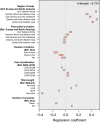North and South: Naming practices and the hidden dimension of global disparities in knowledge production
- PMID: 35238625
- PMCID: PMC8915996
- DOI: 10.1073/pnas.2119373119
North and South: Naming practices and the hidden dimension of global disparities in knowledge production
Abstract
SignificanceContemporary social sciences aim to be diverse and inclusive, but traces of the historical dominance of Western European and North American academic institutions persist in scientific practices. One such practice is the phrasing of article titles. Our analysis shows that articles studying the global North are systematically less likely to mention the name of the country they study in their title compared to articles on the global South. This constitutes, potentially, an unwarranted claim on universality and may lead to lesser recognition of global South studies. Social and behavioral scientists must reflect on the phrasing of their article titles to avoid reproducing harmful relations of intellectual domination which limit inclusivity and constitute a barrier to the generalizability of scientific knowledge.
Keywords: Eurocentrism; global inequalities; knowledge production.
Conflict of interest statement
The authors declare no competing interest.
Figures




References
-
- Bhambra G. K., Holmwood J., Colonialism and Modern Social Theory (Polity Press, 2021).
-
- Grosfoguel R., Racismo/sexismo epistémico, universidades occidentalizadas y los cuatro genocidios/epistemicidios del largo siglo XVI. Tabula Rasa 19, 31–58 (2013).
-
- Quijano A., Coloniality of power and Eurocentrism in Latin America. Int. Sociol. 15, 215–232 (2000).
-
- Wallerstein I., A world-system perspective on the social sciences. 1974. Br. J. Sociol. 61, 167–176 (2010). - PubMed
-
- Go J., Race, empire, and epistemic exclusion: Or the structures of sociological thought. Sociol. Theory 38, 79–100 (2020).
LinkOut - more resources
Full Text Sources

